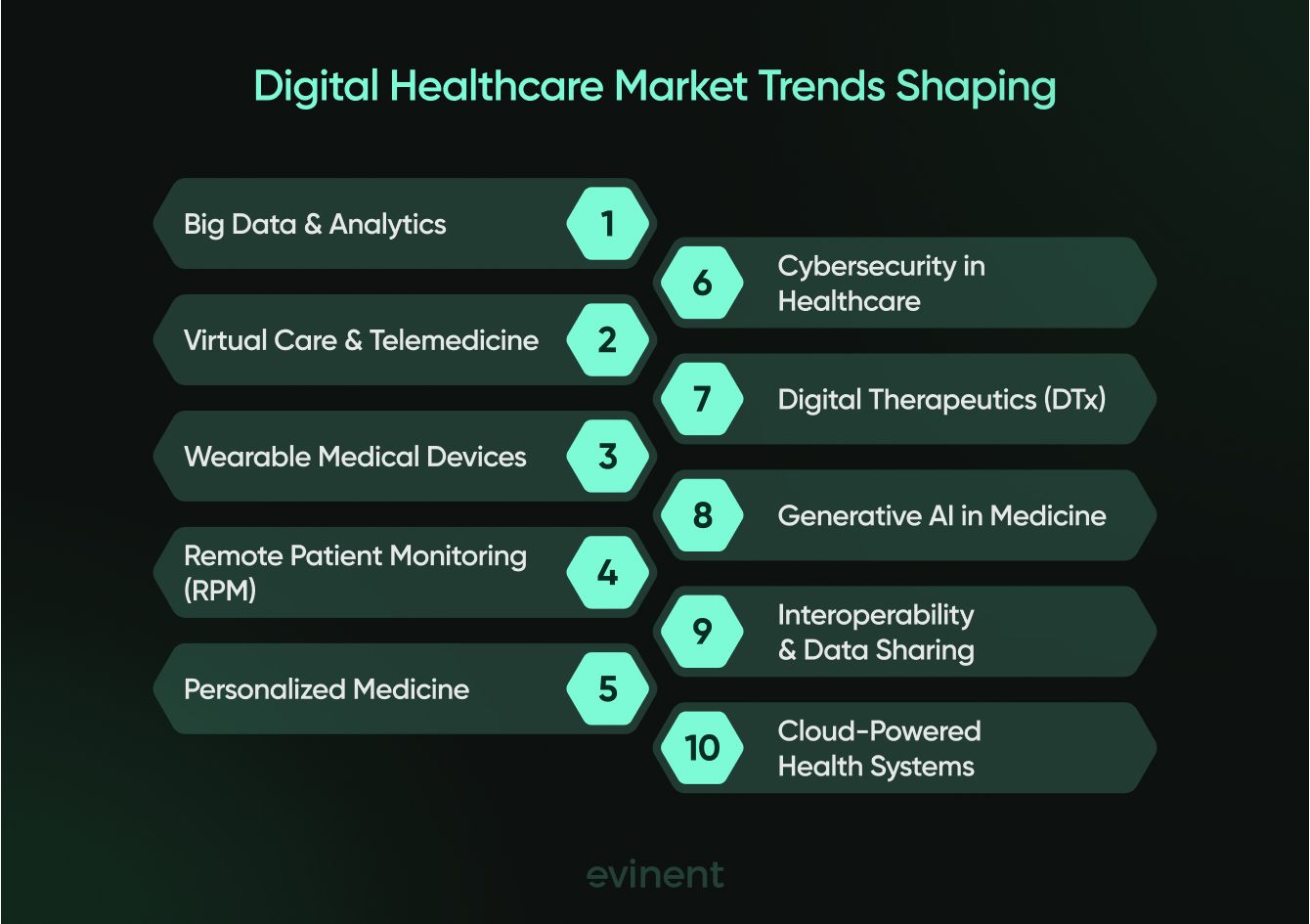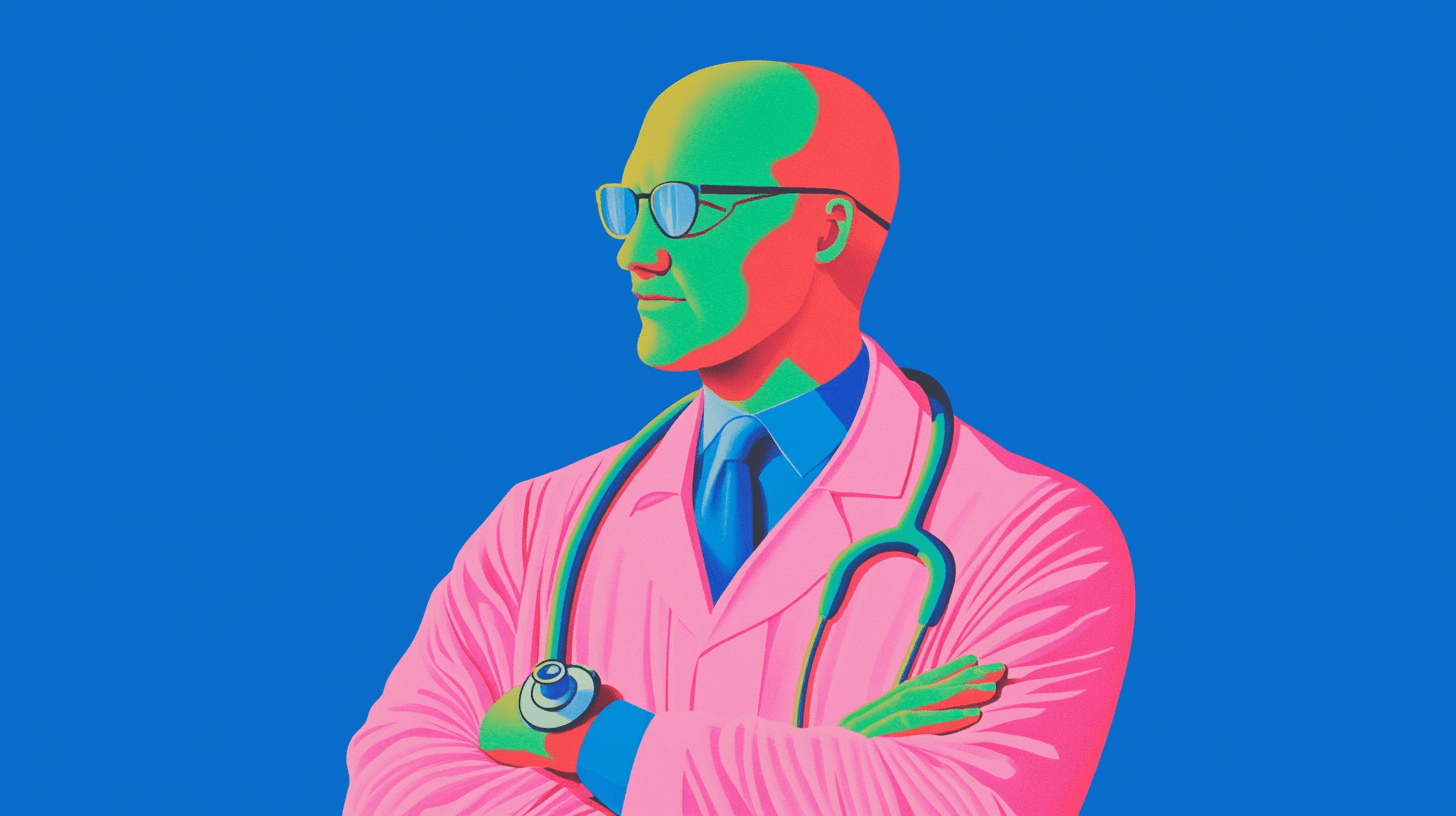The future of healthcare isn’t arriving — it’s already here, digitized and running on code. In 2025, the digital healthcare market is no longer an emerging category. It’s a core pillar of how care is delivered, measured, and monetized.
Fueled by AI, accelerated by the pandemic, and sustained by consumer demand, digital health trends are now reshaping care models from the inside out. From predictive analytics to wearables that flag health issues before symptoms appear, innovation is no longer just a clinical advantage — it’s a competitive necessity.
But this transformation goes beyond devices and dashboards. It’s about rethinking what “care” means in an interconnected world — and who gets access to it.
Let’s unpack what’s driving the digital healthcare market trends in 2025, where the real opportunities lie, and how businesses, providers, and technology leaders can respond strategically.
What Is Digital Healthcare?
Digital healthcare refers to the integration of technology into every layer of the healthcare ecosystem — from diagnosis and treatment to patient engagement, data management, and operational workflows.
It includes:
Telehealth and virtual care platforms
Mobile health (mHealth) apps
Electronic medical records (EMRs)
Remote patient monitoring (RPM)
AI and machine learning in diagnostics and operations
Personalized medicine tools
Wearables and connected devices
Health data analytics platforms
Digital therapeutics (software-based treatments)
At its core, digital healthcare bridges the gap between patients and providers through smart, scalable, and often automated interactions. It’s not just about digitizing records — it’s about delivering care that is accessible, personalized, efficient, and data-driven.
In 2025, the global digital health market is growing at an annual rate of 11.7%, projected to surpass $1 trillion by 2034. Growth is fueled by AI, IoT, robotics, remote monitoring, and expanding health IT infrastructure — all meeting the rising expectations of an increasingly tech-savvy, health-conscious population.
Digital Access and Equity: Closing the Healthcare Gap
While digital health opens new doors, it also risks widening old divides — unless equity is intentionally designed into systems from the very start.
Broadband Before Blockchain
Access to reliable internet remains the most basic — and often the most overlooked — requirement for participating in digital healthcare. In many rural and underserved areas, broadband infrastructure is limited or non-existent, making telehealth, remote monitoring, or cloud-based EMRs essentially unusable.
Socioeconomic status, education level, and geography are the strongest predictors of digital health access.
People in rural areas or from lower-income households are disproportionately disadvantaged.
The COVID-19 pandemic magnified these disparities, making digital connectivity not just a convenience but a lifeline.
Even with ambitious national programs — such as the Ayushman Bharat Digital Mission in India, broadband expansion in Rwanda and Ghana, or national health insurance initiatives in Africa — digital health cannot succeed where digital infrastructure doesn’t exist or isn’t affordable.
Tech Shouldn't Forget Traditional
Digital health strategies that ignore traditional healing practices, cultural norms, or regional languages often fail to gain traction. Localized, culturally adaptable design builds trust and ensures adoption.
Countries like Brazil and Finland have demonstrated the value of user-centered design in their national health platforms, integrating features like multilingual support, region-specific workflows, and culturally relevant health education content.
Tools That Bridge Inequality
Innovative digital tools are emerging to close these gaps:
Low-bandwidth, cloud-based EMRs with offline functionality for rural clinics
Mobile-first care models like Halodoc, which operate effectively even in low-connectivity regions
Multilingual hospital information systems that lower language barriers
Social determinants of health (SDOH) analytics to identify and address non-clinical drivers of poor health outcomes, such as housing, education, and food insecurity
Research from Rwanda, Ghana, and India shows that targeted digital literacy programs, combined with investment in rural infrastructure and gender equity initiatives in the digital health workforce, improve both adoption rates and healthcare outcomes.
The Persistent Digital Divide
Despite progress, millions still lack access to essential health services without financial hardship. Vulnerable populations — including women, minority groups, older adults, and those with limited education — often benefit the least from digital health advancements.
Studies warn of a growing “digital divide” between the haves and have-nots in healthcare technology utilization. Without equity-focused policy, infrastructure investment, and inclusive design, digital transformation risks reinforcing the very structural inequalities it seeks to solve.
Recommendations
Closing the healthcare gap requires coordinated action across policy, technology, and education:
Affordable internet: Subsidies or tiered pricing models to ensure access in underserved areas
Infrastructure investment: Prioritizing rural and remote regions for broadband rollout and device availability
Inclusive design: Embedding accessibility, cultural adaptability, and multilingual support into all digital health products
Digital literacy training: Community-based programs to build user confidence and engagement
Gender equity: Actively promoting women’s participation in the digital health workforce to ensure diverse perspectives in design and delivery
Digital health equity is about far more than giving people an app. It’s about removing structural barriers and ensuring that the digital revolution in healthcare delivers benefits to everyone — especially those who have historically been left behind.
The Consumerization of Healthcare: Patients as Health Shoppers
In 2025, patients are no longer passive recipients of care; they’re informed, empowered consumers with rising expectations, more options, and less tolerance for inefficiency. Healthcare is shifting from a provider-centric system to a consumer-first service model, where control, convenience, and transparency aren’t perks — they’re baseline requirements.
From Sick Care to Self-Care
The rise of mHealth technologies, fitness apps, and chronic disease management platforms has shifted responsibility — and control — toward the individual.
People now:
Track vitals and fitness metrics in real time
Monitor medications with reminder apps and connected pillboxes
Receive AI-driven behavioral nudges via personal health record (PHR) platforms
Access wearable-enabled dashboards that share data directly with providers
Healthcare is becoming a continuous, everyday experience — not just something that happens in a clinic once symptoms appear.
Generational influence is accelerating this trend. Millennials and Gen Z expect real-time access, clear pricing, and intuitive user interfaces. They’re driving demand for healthcare that feels as smooth as ordering from an e-commerce site.
Expectations, Meet Experience
Modern patients want:
Transparency in pricing and outcomes — not vague estimates. Rising healthcare costs and high-deductible plans have made consumers far more price-conscious. Yet, 81% of provider directory entries still contain inaccuracies, frustrating patients despite transparency mandates.
Fast, intuitive digital interfaces — slow, outdated portals risk losing patients to more tech-savvy competitors.
Personalized recommendations — AI-powered care platforms are delivering tailored suggestions based on health history, lifestyle, and wearable data.
Frictionless communication — missed calls and ed messages can cost providers business. Studies show about 69% of patients will consider switching providers due to poor communication.
In response, providers are adopting value-based care models, customizing treatment plans, and using AI-powered platforms to predict health risks and guide preventive care. Patient feedback systems now resemble retail service rating models, helping consumers compare and choose providers more confidently.
Healthcare as a Consumer Service
Patients increasingly expect healthcare to operate like other consumer services: convenient, flexible, and personalized. This is driving:
Virtual care growth — telehealth, online triage, and asynchronous messaging are becoming default first-touch points.
Remote patient monitoring — allowing patients to remain at home while receiving continuous oversight for chronic conditions.
Self-care product adoption — from at-home diagnostics to wellness subscriptions.
Insurance companies are joining the shift. New consumer-centric insurance plans offer app-based price and quality transparency. Early adopters of such models have reported patients choosing high-quality providers 60–80% of the time, compared to just 20% previously.
Retail Health: Clinics in the Cloud
Tech giants and retail chains — Amazon, CVS, Walmart — are scaling retail healthcare models, offering:
Same-day virtual visits
Drive-thru diagnostics and vaccinations
AI-based triage to route patients to the right care level
In-app prescription ordering and delivery
Healthcare is moving closer to the consumer in tone, accessibility and geography. It’s no longer “Doctor will see you now.”
It’s “You’ll see the doctor when and how you want — online, in-store, or from your phone.”
The Rise of Health Super Apps
In Asia-Pacific markets, health super apps are emerging as one-stop healthcare hubs. These platforms combine:
Virtual consultations
Medication ordering and delivery
AI-driven wellness coaching
Personal health record management
Insurance claim processing
For consumers, it means no more juggling multiple apps — everything is integrated into a single, seamless experience.
AI, Data, and the Personalization Engine
AI is now embedded directly into consumer-facing healthcare tools:
Context-aware care navigation that suggests the right service based on real-time data
Large language models in health apps that provide reliable, on-demand medical guidance
Dynamic care plans that adapt as wearable and monitoring data changes
This personalization at scale is transforming patient engagement from reactive to proactive, and building brand loyalty for providers who embrace it.
Market Dynamics: Consumerism Meets Growth
The consumer healthcare market is growing at a CAGR of 7–11%, fueled by:
Expanding telehealth and mHealth adoption
Rising self-care product consumption
Omnichannel healthcare experiences that blend physical and digital touchpoints
Increasing focus on sustainability in healthcare products and services
Providers and payers who embrace transparency, digital integration, and personalized care delivery are seeing higher retention, improved health outcomes, and stronger market positions.
The consumerization of healthcare in 2025 is about more than digital convenience — it’s about empowering patients to act as informed decision-makers. Those who meet these demands with seamless, transparent, and personalized care experiences will win not just patients, but loyal, long-term customers.

Digital Transformation in Healthcare: Beyond Trending Terms
What used to be a decade-long roadmap for digital adoption in healthcare has compressed into a few short years. In 2025, digital transformation in healthcare isn’t just a project — it’s the operating model.
The goal? Deliver smarter, safer, and more sustainable care, at scale.
The Rise of Intelligent Infrastructure
Hospitals and clinics are moving from reactive systems to predictive ecosystems powered by:
Electronic Medical Records (EMRs) that sync across departments and devices
Enterprise Resource Planning (ERP) tools for smarter operations and staffing
Cloud computing that stores and secures patient data without local bottlenecks
Cybersecurity measures tailored to healthcare’s unique threat landscape
In fact, some of the most forward-looking providers are redesigning their infrastructure to run entirely on cloud-native architecture, improving agility, compliance, and uptime.
AI Isn’t Just for Diagnosis Anymore
Yes, AI in healthcare is assisting radiologists in spotting tumors and flagging anomalies. But in 2025, its influence goes far deeper:
Predictive analytics helps forecast patient deterioration, ER surges, or readmission risks.
Natural language processing (NLP) extracts key insights from unstructured clinical notes.
Machine learning models help hospitals optimize bed turnover, resource allocation, and even billing cycles.
AI is becoming the silent partner in day-to-day care: streamlining workflows, reducing burnout, and letting clinicians spend more time with patients, not paperwork.
Virtual Health Is Now Just… Health
The pandemic was the spark. Now, telehealth platforms, patient portals, and virtual health services are standard offerings, not futuristic experiments.
Patients expect to:
Book appointments online
Access lab results without a call
Message their doctor from an app
Join video consults from their living room
Monitor conditions via wearable devices that sync to the EMR
The biggest shift? Care delivery is no longer limited by geography or even physical space. Your next doctor visit might happen via smartwatch, not stethoscope.
Regulatory and Policy Considerations: Innovation Meets Oversight
As digital healthcare expands, so do the rules and the risks. In 2025, regulators are playing catch-up, working to safeguard patient safety without stifling innovation.
Data Privacy Is Now a Dealbreaker
Healthcare data isn’t just sensitive, it’s sacred. With the rise in ransomware attacks, phishing schemes, and cloud breaches, data privacy and cybersecurity have become front-and-center compliance priorities.
Governments are enforcing stricter mandates around:
Encryption and data localization to keep health records secure and jurisdictionally compliant
Consent management and explicit patient data rights
Audit trails and breach notifications with legally defined response timelines
Failure to meet these requirements can result in regulatory penalties, exclusion from reimbursement programs, or immediate loss of patient trust.
Funding Pressures and Medicaid Cuts
One of the most urgent policy concerns is the potential loss of hundreds of billions of dollars in Medicaid funding over the next decade under proposed federal budget changes.
Such cuts would disproportionately affect:
Rural health systems, already operating on thin margins
Safety-net hospitals serving low-income populations
Local economies dependent on healthcare jobs
For patients, this could mean reduced access to essential services, longer travel times for care, and increased out-of-pocket costs.
Drug Pricing Legislation and the 340B Program
States are taking an increasingly active role in drug price regulation. Around 30 states have pending bills, and several have passed laws to protect the 340B Drug Pricing Program, which allows safety-net hospitals to purchase medications at discounted rates.
Manufacturers are pushing back, but legislative momentum is strong — driven by the need to protect financially vulnerable healthcare providers from losing access to affordable medications for their patients.
AI, Meet Regulation
As AI becomes embedded in diagnostics, treatment planning, and administrative workflows, critical questions emerge:
Who is accountable if an algorithm misdiagnoses?
Can patients request a second opinion from a human provider?
How do we detect and prevent bias in AI models trained on incomplete datasets?
Regulators are responding:
FDA, Health Canada, TGA, and the EU’s MDR and IVDR are refining their AI governance frameworks.
India’s DISHA framework is setting new precedents for digital health data rights and patient consent standards.
Regulatory Uncertainty and Strategic Impact
A recent survey of U.S. healthcare executives found:
Nearly 60% expect recent and upcoming regulations to significantly influence their 2025 strategies.
44% report regulatory uncertainty as a major factor shaping strategic decisions.
This uncertainty is especially acute for health plans, facing evolving policies on:
Pharmacy benefit management (PBM) oversight
Site-neutral payment reforms
Drug pricing regulations
Federal vs. State Oversight Shifts
With changes in federal administration, regulatory authority is increasingly decentralizing to the states. This fragmentation creates compliance complexity for multi-state providers but may also reduce bureaucratic bottlenecks in certain markets.
Workforce and Compliance Mandates
In 2025, compliance goes beyond technology and finance, it extends into the workplace:
OSHA is strengthening workplace safety enforcement, particularly in high-risk healthcare environments.
Paid family and medical leave mandates are expanding in multiple states, adding administrative requirements for healthcare employers.
Payment and Reporting Updates
Medicare and Medicaid reimbursement changes now support advanced care management and preventive services billing in rural health centers and federally qualified health centers (FQHCs).
Ambulatory Surgery Centers must meet new quality reporting requirements to maintain reimbursement eligibility.
Emerging Regulatory Trends
Regulators are also sharpening their focus on:
Interoperability standards for health IT
AI governance in clinical and operational settings
Data privacy compliance tied to expanding digital health technologies and cloud migration
Industry Confidence Despite Challenges
Despite the complexity, industry sentiment remains optimistic:
69% of healthcare leaders expect revenue growth in 2025
71% anticipate improved profitability
This cautious optimism reflects a belief that organizations able to integrate compliance into their innovation strategies will gain a competitive advantage.
The regulatory environment in 2025 is dynamic, fragmented, and high-stakes. Healthcare leaders must navigate evolving policies on funding, drug pricing, digital technology, and workforce regulation, all while ensuring their innovations remain ethical, transparent, and legally compliant.
Digital Healthcare Market Trends
The following trends are not just popular terms: they’re the forces driving real change across the digital health industry. Let’s explore the most impactful developments.
Big Data & Analytics
Healthcare has always been rich in data; now it’s finally usable. With big data, EHR/EMR systems, and health information exchange (HIE) tools working together, providers can:
Predict outbreaks and demand surges
Personalize care with high-resolution patient profiles
Identify care gaps and underserved populations
Conduct regression and time series analysis to optimize resources
Use agentic AI to act on insights without manual intervention
The result? Data that’s not just collected, but actually acted on.
Virtual Care and Telemedicine
The digital health market has fully embraced virtual care: from diagnostic apps to video consultations, remote monitoring, and medication management tools.
What’s new in 2025?
Chronic disease management apps are now clinically validated
Wearables feed real-time vitals to care teams
Connected devices handle everything from glucose monitoring to ECGs at home
Telemedicine is covered by national insurance in many countries
Virtual is no longer a backup plan. It’s the first line of care for millions.
Wearable Devices: Healthcare That Moves With You
In 2025, wearable devices are no longer just fitness accessories, they’re certified medical tools. FDA-cleared smartwatches can now detect irregular heart rhythms, track oxygen saturation, monitor glucose levels, and even perform single-lead ECGs.
What’s driving adoption:
Real-time monitoring for chronic conditions like diabetes, hypertension, and heart disease
Integration with EMRs, giving physicians instant access to longitudinal health data
Insurance incentives for patients who meet activity or wellness goals
The most advanced devices now feature predictive s, warning user and their care teams of anomalies before symptoms appear. For providers, this means fewer emergency visits. For patients, it means more control over their own health.
Remote Patient Monitoring (RPM): Extending Care Beyond the Clinic
Remote Patient Monitoring has shifted from pilot programs to standard practice, especially for chronic care management. Using connected devices and mHealth apps, providers can:
Track vitals 24/7
Adjust medication dosages remotely
Intervene earlier in cases of deterioration
Reduce unnecessary hospital readmissions
Cloud-based dashboards now compile RPM data into actionable reports, integrated with AI-powered risk scoring. For example, a patient’s subtle changes in breathing patterns might trigger a nurse call, days before a full-blown COPD exacerbation.
The economic case is clear: RPM reduces strain on hospital resources while improving patient outcomes. In some health systems, reimbursement parity with in-person visits has accelerated adoption.
Personalized Medicine: From Average to Individual
Gone are the days of “one-size-fits-all” treatment. In 2025, personalized medicine uses genomic data, biomarkers, and patient lifestyle information to craft therapies that are as unique as a fingerprint.
Key drivers:
Affordable genome sequencing
AI algorithms that correlate genetics with treatment outcomes
Integration of personal health data from wearables, apps, and EMRs
From oncology to mental health, personalized medicine is improving efficacy while reducing side effects. For example, cancer patients may receive drug combinations tailored to their tumor’s genetic profile, increasing survival rates while minimizing toxicity.
Cybersecurity: Guarding the Digital Frontlines
The digital healthcare market is a prime target for cyberattacks, with ransomware incidents hitting hospitals, insurers, and even wearable device ecosystems.
In 2025, the focus has shifted from reactive defense to proactive prevention:
Zero-trust architectures limit access even inside the network
AI-based threat detection systems identify anomalies in real time
Multi-factor authentication and biometric logins are standard for patient portals
Continuous security audits are required by regulators in many regions
The stakes are high: a breach isn’t just a financial risk, but a patient safety issue. Compromised medical devices or altered patient records can lead to misdiagnoses or ed treatment.
Digital Therapeutics (DTx): Software as a Prescription
Digital therapeutics are clinically validated software applications that treat, manage, or prevent diseases. Unlike general wellness apps, DTx products undergo rigorous clinical trials and regulatory approval.
Examples in 2025:
CBT-based programs for anxiety and depression
Digital rehab plans for post-stroke recovery
Mobile platforms for diabetes self-management
Payers are beginning to reimburse DTx just like pharmaceuticals, especially for chronic and behavioral health conditions where traditional care is costly or inaccessible.
Generative AI: The Next Leap in Digital Healthcare
If 2023 was the year healthcare started experimenting with GenAI, 2025 is the year it became embedded.
Applications include:
Automated clinical documentation, reducing physician admin time by 70%+
AI-assisted diagnosis based on multimodal data (imaging, lab results, genomics)
Treatment plan generation tailored to patient history and evidence-based guidelines
Patient education in plain language, dynamically generated from clinical notes
While the technology is transformative, it also brings new concerns: explainability, bias, and the need for rigorous validation. As a result, many health systems are pairing GenAI outputs with mandatory human review.
Interoperability: Breaking the Data Silos
True digital healthcare transformation depends on interoperability, the ability of different systems to share, understand, and act on health data.
Progress in 2025:
Widespread adoption of FHIR (Fast Healthcare Interoperability Resources) standards
National and regional health information exchanges (HIEs) that connect hospitals, clinics, labs, and insurers
APIs enabling secure third-party app integration into EMRs
AI-powered mapping tools that reconcile mismatched data formats in real time
The payoff: fewer repeated tests, faster diagnoses, and a smoother patient journey across multiple providers.
Yet, challenges remain: from outdated legacy systems to competitive reluctance. The organizations that solve interoperability first will hold a serious competitive advantage in the digital health industry.

Workforce & Organizational Change: Preparing People for a Digital-First Future
Technology is only as effective as the people using it. In 2025, healthcare organizations are rethinking not just their tech stack, but their workforce strategy.
Addressing Talent Shortages
The healthcare workforce shortage is no longer a looming threat. From nurses to IT specialists, the gap is widening as demand for care grows.
Digital health tools can help by:
Automating repetitive administrative tasks (administrative burden reduction)
Enabling workflow redesign that prioritizes patient-facing time
Supporting team restructuring to leverage remote care coordinators and AI-driven triage
But automation isn’t a magic bullet. Without targeted hiring and training, the tech-human gap can still leave patient needs unmet.
Education & Upskilling
Digital transformation means every role — from surgeons to schedulers — requires new skills. Forward-looking organizations are investing in:
Continuous education programs for digital tool usage
Simulation-based training for telehealth and AI-assisted diagnostics
Cybersecurity awareness for all staff, not just IT teams
Hospitals with in-house cloud environment labs are even letting clinical staff “test drive” new systems before they’re rolled out live.
Workforce Engagement & Well-Being
Change fatigue is real. Organizations that succeed in digital adoption balance performance expectations with mental health support, offering flexible scheduling, access to well-being resources, and recognition programs that celebrate digital champions.
Sustainability & Future Outlook: Health Systems in a Warming World
Healthcare in 2025 sits at the intersection of two urgent realities: it is both a frontline responder to climate change and a significant contributor to the crisis. As the digital healthcare market grows, with sprawling data centers, manufacturing of connected devices, and expanded telehealth networks, so does the sector’s carbon footprint.
The numbers are sobering. Globally, healthcare contributes around 5% of total greenhouse gas emissions — a figure that reaches up to 10% in the United States. These emissions stem from energy-intensive hospital operations, medical supply chains, and the expanding digital infrastructure that underpins modern care. With aging populations and rising disease burdens, this footprint will only grow unless systems take deliberate action.
Climate-Conscious Healthcare
Climate change is not just an environmental issue; it’s a public health emergency.
Air pollution remains the second leading global risk factor for death, responsible for 8.1 million deaths in 2021.
By 2030, climate-related health impacts could push 40 million people into extreme poverty.
Extreme heat events, floods, and severe storms are already disrupting care delivery and damaging health infrastructure in vulnerable regions.
Forward-looking health systems are making sustainability a boardroom priority, recognizing that climate action brings not only environmental benefits but also measurable health and financial gains. For example, reducing emissions from hospital fleets and power sources can cut rates of asthma, cardiovascular disease, and heat-related illnesses, lowering emergency department visits and costs.
Key initiatives gaining traction in 2025 include:
Carbon footprint tracking for digital health operations and supply chains
Migration to energy-efficient cloud infrastructure, reducing the load on physical data centers
Procurement policies that favor low-emission devices, wearables, and manufacturing partners with transparent ESG reporting
Telehealth technologies that reduce travel-related emissions for both staff and patients
The UK’s National Health Service provides a global model: over 30% of its energy is now renewable, and new hospitals built to PassivHaus standards use 50% less energy than facilities designed in the early 2000s. These moves protect operations against energy price volatility while significantly reducing environmental impact.
Sustainability Pays Off
Green initiatives aren’t just ethical, but economically sound. Nearly 500 hospitals worldwide that implemented environmental programs report collective savings of $203 million annually, proving that cutting waste and improving efficiency often lead to healthier bottom lines.
Balancing Innovation & Security
The future of digital health will be shaped not just by innovation, but by its ability to withstand climate-related disruptions while safeguarding patient trust. Strategic planning now involves:
Mapping market drivers and restraints for climate-resilient tech adoption
Stress-testing infrastructure against extreme weather and supply chain interruptions
Building redundancy into remote patient monitoring and telehealth systems to ensure continuity during crises
Embedding environmental accountability into governance frameworks for health organizations
Looking Ahead to 2030
The path forward is clear: by the end of the decade, healthcare must become more virtual, personalized, and climate-aware, but achieving it without sacrificing security or accessibility. A truly net-zero health system will rely on:
Climate-friendly technologies in diagnostics, data storage, and medical devices
Integration with public services to improve both environmental and social outcomes
Science-based targets and transparent reporting to ensure accountability
Equitable design, ensuring that sustainability efforts do not inadvertently exclude vulnerable populations
In a warming world, health systems can no longer treat climate resilience as an optional initiative. The sector’s dual role, as both a contributor to and a responder in the climate crisis, demands urgent, scalable action to cut emissions, strengthen infrastructure, and embed sustainability into every layer of healthcare delivery.
Market Growth & Investment Trends: Where the Money’s Flowing
The digital health market size in 2025 is projected to exceed $660 billion globally, with a CAGR of over 20% in some subsegments. But growth isn’t uniform: certain areas are seeing outsized investment.
Hot Investment Areas
mHealth startups focusing on chronic care, mental health, and women’s health
Alternative sites of care platforms, including home hospital programs
Cybersecurity protocols for healthcare-specific threats
AI-powered diagnostic and triage tools
Interoperability solutions with proven ROI for providers
Government Initiatives Fueling Growth
National governments are actively funding digital health infrastructure. Examples include:
Expansion of broadband access for rural telehealth
Grants for hospital information systems modernization
Subsidies for cloud migration in public hospitals
These incentives are helping overcome initial adoption costs, especially for mid-sized health systems and emerging markets.
Regional Dynamics
North America: Still the largest market, driven by AI adoption and high private-sector investment
Europe: Growth accelerated by MDR/IVDR compliance and cross-border EHDS interoperability goals
Asia-Pacific: Rapid mHealth adoption via mobile-first strategies in India, Indonesia, and China
Middle East: Government-led healthcare digitization under national transformation plans
For investors, the message is clear: Follow the policy. Regions with strong regulatory support and digital infrastructure will dominate the next decade of digital healthcare market trends.
How Evinent Can Help with AI Healthcare Software Development
At Evinent, we understand that building the right healthcare technology is about aligning clinical workflows, regulatory compliance, and patient needs into a solution that delivers real-world results.
We work with enterprise and mid-sized healthcare organizations to design, develop, and deploy AI-powered solutions that address the most pressing digital health challenges.
Our expertise includes:
AI-Driven Diagnostics
Custom algorithms for imaging analysis, anomaly detection, and clinical decision support.
Remote Patient Monitoring Platforms
Integrated with wearables, IoT devices, and cloud dashboards for continuous care.
Healthcare Data Analytics
From predictive modeling to population health insights, we help you make sense of complex EMR and claims data.
Interoperability Solutions
FHIR-compliant APIs and data mapping to ensure your systems speak the same language.
Cybersecurity & Compliance
GDPR and regional regulatory frameworks built into the architecture from day one.
Our process is collaborative, transparent, and measurable, so whether you’re modernizing legacy infrastructure or launching a net-new digital health platform, you know exactly how technology is improving care and ROI.
Benefits of Healthcare Technology Innovations for Your Business
Adopting cutting-edge healthcare technology in 2025 isn’t just about staying competitive, but about creating new value streams, improving patient care, and reducing operational strain.
1. Improved Patient Outcomes
Digital tools, from AI diagnostics to personalized medicine platforms, enable earlier detection, more precise treatment, and faster recovery times. Patients benefit from fewer complications, while providers see higher satisfaction scores and stronger care quality metrics.
2. Operational Efficiency
Automation, predictive analytics, and integrated platforms streamline workflows, reduce administrative burden, and free up staff time. This means lower overhead costs and the ability to serve more patients without sacrificing quality.
3. Revenue Growth Opportunities
New care models such as subscription-based remote monitoring or reimbursable digital therapeutics are opening fresh revenue channels. Paired with data-driven marketing and patient engagement strategies, these innovations can drive sustained business expansion.
Final Thoughts: The Digital Healthcare Market
The digital healthcare market trends of 2025 tell a clear story: technology is no longer an optional upgrade; it’s the backbone of modern healthcare. From AI-powered care delivery to sustainable operations, the winners in this market will be the organizations that integrate innovation seamlessly into their strategy, operations, and patient relationships.
Healthcare leaders face a choice: adapt now, or be left behind as the industry moves toward a more connected, personalized, and data-driven future.
Evinent is here to help you make that transition without losing sight of what matters most: delivering better care to more people, more efficiently, and more securely than ever before.






